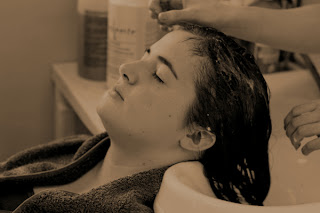Have you ever wondered if you could find a better shampoo?
One that works better?
One that works better?
Often shampoo is found to become less effective over time (or possibly it wasn't effective in the first place). Do you think it's possible that a shampoo can be suited to addressing the needs of both your hair and your scalp? It would be great if we could find a shampoo which actually becomes more effective and provides greater benefits with continuous use.
STUFF that harmsThe main ingredients in most shampoos (next to Water/Aqua) are Sodium Lauryl Sulphate (SLS) and/or Sodium Laureth Sulphate (SLES). They are actually known to be skin irritants:
Sodium Lauryl Sulfate - Sensitivity
Sodium Laureth Sulfate - Irritation
This would be particularly interesting to anyone with sensitive skin, prone to eczema, dermatitis or psoriasis. Some mothers are also aware that their children have more sensitive skin and can develop allergies and reactions to products with a high concentration of SLS and SLES.
Beauty traitor in your home
To start with, SLS becomes extremely alkaline (high pH) in the presence of water, and therefore highly aggressive on the hair and scalp (which favours a slightly acidic environment). On top of that, it also disrupts the natural oil balance (nature's moisturiser and skin protector) and can cause allergies, aging/dehydration, and the above-mentioned conditions especially to people exposed to regular use.
By stripping the skin of moisture,
SLS exacerbates over-active or under-active sebaceous glands
and so worsens the problems of oily or dry skin.
SLS exacerbates over-active or under-active sebaceous glands
and so worsens the problems of oily or dry skin.
Though SLS is generally tolerated in accepted concentrations found in cosmetic products, it is, however, used frequently used in household products so it should not come as a surprise that one is exposed to it regularly, throughout each day, in liquid hand soap, shampoo, body wash, bubble bath, dish-washing liquid and household detergents. It is also used in beauty products and hair colouring products.
STUFF to avoid at all costs
- Formaldehyde is toxic, allergenic and carcinogenic. Why they add it to shampoo and other cosmetic products is beyond me.
STUFF that's ok..
And STUFF that helps
Apart from SLS as the predominant cleanser and foaming agent, the other ingredients in shampoo are mostly there for cosmetic purposes; to improve the texture, softness, cleansing ability and fragrance, as well as having preservative properties.And STUFF that helps
Generally, there are few ingredients which provide considerate benefit to one's body, and those ingredients are often not in a sufficient concentration to make a significant difference (If they were, shampoo would be a lot more expensive).
If you need to look for an alternative to SLS, or look for a product which uses lower proportions of SLS, look for Cocamidopropyl betaine listed before SLS, or in place of SLS in the ingredients list. It provides a similar cleansing effect but it less harsh and allergic reactions are uncommon in comparison to SLS.
A completely new and uncommon ingredient for cleansing is Zinc coceth sulphate. This can also be used in place SLS or Cocamidopropyl betaine. It is derived from Coconut and Zinc, with an acidic pH of 4.5 (similar to healthy skin and hair), it is very mild and gentle on the skin, and due to its ability to deposit zinc basic salts onto the skin, it works against dandruff. It is an excellent ingredient which effectively addresses hair cleansing and scalp care needs, simultaneously.
Now can you see how it is possible to assess a shampoo quickly and determine which is more likely to be effective and provide greater benefits with continuous use?
Another thing to look at is pH level. Most shampoos should be somewhat acidic, ranging between 4 and 6 (or a bit lower). Unfortunately most shampoos do not actually display the pH level on the label so it's hard to distinguish them, but it is preferable to use on which is similar to the pH of healthy skin.
An acidic pH is also preferable to counteract the effect that hard water has on our hair and scalp. Hard water is quite common around the world. It contains dissolved minerals and is likely to be neutral to slightly alkali. In an alkaline environment the cuticles (outer layer) of the hair open up and expose the hair to weakening and damage. An acid shampoo can help prevent this and thus protects and maintains the hair structure
Recommendations
I use two brands of shampoo in my salon. Both are free of SLS, provide excellent results and are very popular with my clients:
- Naturalmente - It is a professional product made in Italy. It is dermatologically tested and is not tested on animals.
- African Organics - It is made from African ingredients and is also not tested on animals.
_______________________
 And my last tip for finding a good shampoo.. Remember, if it's not good for your face you shouldn't be putting it on your scalp and hair!
And my last tip for finding a good shampoo.. Remember, if it's not good for your face you shouldn't be putting it on your scalp and hair! I trust the products that I use to wash my hair to such a degree that I am comfortable washing my face with them! How many hair professionals can say that about the products they recommend? :)

